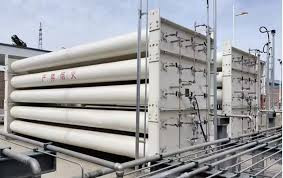views
The hydrogen storage tank market is entering a transformative era driven by the accelerating shift toward clean energy. As nations prioritize decarbonization and invest in hydrogen as a key solution, hydrogen storage technologies—particularly tanks—are becoming more critical. These tanks ensure hydrogen is safely and efficiently stored across a wide range of sectors, including transportation, industrial energy use, and power generation. This article explores the key future trends expected to shape the hydrogen storage tank market, revealing how innovation, policy support, and evolving applications will drive long-term growth.

Growth of Hydrogen Economy and Its Impact
As global demand for hydrogen rises, the hydrogen economy is shifting from pilot projects to scalable infrastructure. The development of a hydrogen value chain—from production and storage to transportation and end use—is gaining momentum. In this ecosystem, storage tanks play a vital role by providing mobility and flexibility, allowing hydrogen to be transported, stored, and accessed when needed.
Hydrogen storage tanks, especially high-pressure (350–700 bar) and cryogenic tanks, are expected to see heightened demand. This is particularly true in fuel cell vehicles (FCEVs), green hydrogen plants, hydrogen refueling stations, and backup power systems. The future of this market will be driven by trends that improve efficiency, safety, and integration into broader energy systems.
Key Future Trends Driving the Market
1. Advancement in Composite Tank Materials
One of the most defining trends is the use of advanced composite materials in Type III and Type IV tanks. These tanks are designed to handle high pressures while reducing overall weight—making them ideal for mobile applications such as trucks, buses, and trains. Manufacturers are investing in carbon fiber innovations and next-generation polymers to increase tank strength, reduce costs, and improve recyclability. Future developments will likely focus on enhancing material durability and optimizing lifecycle performance.
2. Rise of Liquid Hydrogen Storage
While compressed hydrogen remains dominant, liquid hydrogen storage is gaining interest, especially in aerospace and maritime sectors. Liquid hydrogen allows for greater energy density, which is crucial for long-haul flights and cargo shipping. The development of double-walled vacuum-insulated cryogenic tanks and advanced thermal management systems will become more prevalent as demand for long-range and space-efficient hydrogen storage increases.
3. Integration with Renewable Energy Systems
Another major trend is the integration of hydrogen storage with renewable energy sources. As solar and wind projects expand, storing excess energy as hydrogen becomes a viable long-duration storage solution. Hydrogen tanks, both stationary and mobile, will increasingly be deployed at renewable energy sites to manage supply-demand fluctuations. These tanks may also support microgrid and off-grid applications, improving energy access in remote areas.
4. Digitalization and Smart Monitoring Technologies
Future hydrogen storage tanks will be more intelligent. The integration of sensors, IoT technology, and predictive analytics will become standard. These smart tanks will allow for real-time monitoring of temperature, pressure, structural integrity, and leakage, enhancing safety and regulatory compliance. Predictive maintenance and remote diagnostics will help reduce operational costs and extend tank lifespans.
5. Localization of Manufacturing and Supply Chains
To meet growing demand and reduce logistical challenges, regional manufacturing of hydrogen storage tanks is set to increase. Local production hubs will emerge, particularly in Asia-Pacific, Europe, and North America. This will lead to shorter supply chains, faster deployment, and better alignment with local regulations and standards. Governments are likely to incentivize domestic production through subsidies, grants, and public-private partnerships.
Sectoral Expansion and Diversification
Transportation
FCEVs are expected to drive the majority of near-term demand. Governments and private players are deploying hydrogen-powered buses, trucks, and trains. As these fleets grow, so will the need for standardized, high-performance hydrogen tanks. The development of ultra-lightweight tanks with longer refueling intervals will be a priority.
Industrial and Power Generation
Industries such as steel, refining, and chemicals are shifting to hydrogen to decarbonize operations. Power generation facilities are exploring hydrogen for blending with natural gas or standalone combustion. These applications require large-scale stationary tanks that can withstand repeated filling cycles and extreme environmental conditions.
Aerospace and Maritime
Future adoption of hydrogen in aviation and shipping will require custom-designed tanks with extremely high energy densities. Cryogenic and hybrid storage solutions will dominate in these sectors, and innovations in insulation and modularity will play a key role in making these applications viable.
Regulatory and Safety Trends
As hydrogen storage proliferates, harmonized safety standards and certifications will be increasingly important. Governments and international bodies are collaborating on creating unified guidelines for tank design, testing, and deployment. Future tanks will be built not just to meet local compliance but to adhere to global benchmarks, easing international transport and adoption.
Conclusion
The future trends in the hydrogen storage tank market reflect the broader evolution of the hydrogen economy. As technological advancements, sustainability goals, and new applications converge, storage tanks will become more efficient, safer, and widely deployed across industries and geographies. Key drivers such as material innovation, renewable integration, digitalization, and sectoral expansion will define the next chapter of this dynamic market.
The coming years will witness increased collaboration between governments, manufacturers, and end users to accelerate deployment and bring down costs. For stakeholders ready to invest in future-ready hydrogen storage technologies, the opportunities are vast—and growing.



Comments
0 comment